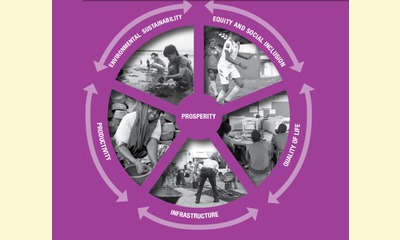|
|
State of Urban Youth Report 2012-2013: Youth in the Prosperity of Cities
un article par Juan Clos, Executive Director, UN Habitat (abridged)
I am pleased to present the second State of the Urban Youth
report focusing on Youth and the Prosperity of
Cities. This Report builds on the 2010/11 edition,
“Leveling the Playing Field – Inequality of Youth
Opportunity” and its insights into the state of
urban youth. Much like the findings of the
previous report, this one provides further
evidence of the fundamental importance of job
oriented education to the development of urban
youth.

click on photo to enlarge
At a time when the global economy is looking for
paths to recovery and seeking innovative, ideas to
rejuvenate itself, young people may offer the best
hope. The events of the Arab Spring demonstrated
that youth can be a powerful social force for
positive change. The unexpected nature of these
events, point to an underlying problem that
afflicts youth in all corners of our world. The
question is, why, in an increasingly urbanised
world, are young people underappreciated by many
governments and not at the forefront of economic
activity and innovation?
The increasing prominence of the youth bulge in
most urban areas presents a unique opportunity, as
they represent the most dynamic human resource
available. Their numbers today are larger than at
any point in human history. Yet this group suffers
the most from urban unemployment and often feels
that they lack equal access to opportunities. This
is especially acute in developing countries, which
have a relatively youthful population that must be
mobilised to realise greater economic and social
development goals.
Today, 90 million youth around the world are
unemployed (or 47per cent of the total number of
unemployed) and an additional 300 million belong
in the “working poor” category —they are in
unskilled, insecure jobs and live in poor
conditions. This Report takes a closer look at the
condition of youth in major urban centres in four
developing nations - Accra (Ghana), São Paulo
(Brazil), Bangalore (India) and Cairo (Egypt). . .
Young people in the survey want equity for better
shared prosperity both for their own and their
cities’ benefit, and they regard education as the
best way of bringing about a more equitable type
of urban development. They point to other
significant challenges like structural constraints
and lack of a democratic culture in their
respective cities. These are issues over which
local authorities wield a degree of influence that
puts them in the best possible position to take
remedial action. Local authorities must also seek
to mainstream youth issues into all aspects of
their planning and operations policy areas.
The report recommends a better match between
skills and labour markets through vocational
training and with the participation of the private
sector. ‘Soft’ skills matter more in service-
oriented economies, young people in informal
settlements need entrepreneurial abilities, and
capacities must be better geared to knowledge-
intensive business services. With their typical
dynamism and energy, young people can exercise a
unique multiplier effect on urban prosperity: the
more they are allowed to benefit, the more they
can give back, for the overall good of the
society. . .
[Note: Thank you to Barry Weisberg, the CPNN
reporter for this article.]
|








|
DISCUSSION
Question(s) liée(s) à cet article:
Is there a renewed movement of solidarity by the new generation?,
* * * * *
Commentaire le plus récent:
from Javier Collado Ruano, Director of Edition at Global Education Magazine, on the occasion of the International Day of Solidarity.
Solidarity is a trans-dimensional phenomenon that goes beyond the ontological essence of human nature. In fact, when we analyze the connections between the microcosm and the macrocosm, we perceive that human beings are not involved in chaos and arbitrariness, but belongs to the large network of interdependencies, complementarities and reciprocities that constitute life. The emergence of life on Earth, around 3,8 billion years ago, was a complex process of exceptional natural phenomena, inherent in all living systems. A process which is expressed through unlimited creativity: mutation, gene exchange, and symbiosis. From a cosmo-biological perspective, we can understand a new conceptual dimension of life, where all living beings share same basis of genetic code: the twenty amino-acids and four phosphatic bases. In fact, the diversity of living beings is caused by the combination of this cosmo-bio-genetic basis.
This trans-dimensional perspective has a deep ecological and spiritual sense for our worldview because the human evolutionary adventure is the latest stage of life on Earth. The modern human being is a vertebrate animal, mammal, belonging to the primates, which emerged 200,000 years ago. In recent centuries he has imposed its anthropocentric, industrial and capitalist vision to the detriment of Pachamama (and Indigenous goddess known as earth mother). We consume around 120% of the natural resources that Earth Mother regenerats annually. Our consumer behavior is immersed in a fatalistic dynamic with a destiny to climate change (deforestation, loss of biodiversity, ozone, etc.), and our own self-destruction as a species.
There is an urgent need to get beyond the cognitive fallacy that the mental structures of social Darwinism and capitalist postulates of the 19th century have historically constituted, because they only understand natural and social systems as warmongers and competitive processes whereby species diverge from each other. . ... continuation.

|
|









